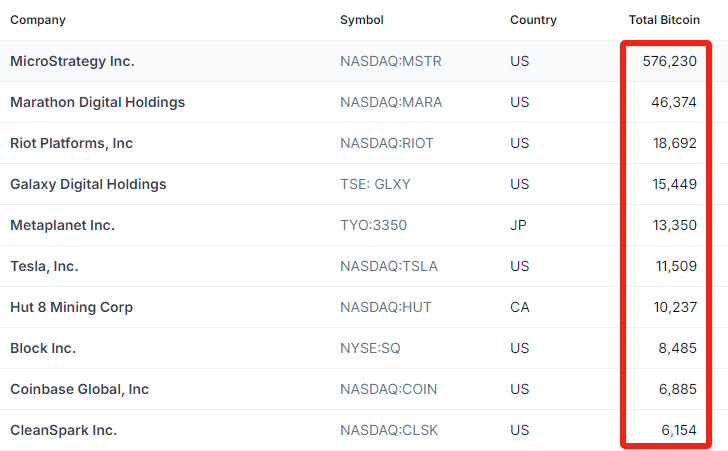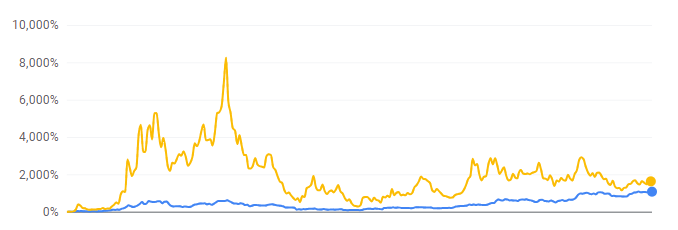Which Public Companies Hold Bitcoin — and How Are Their Stocks Performing?


Introduction: Bitcoin as a Corporate Treasury Asset
TradingKey – As Bitcoin (BTC) evolves from a speculative asset into a strategic treasury reserve, more publicly traded companies are adopting BTC as part of their balance sheet strategy. These firms view Bitcoin not only as “digital gold” to hedge against inflation, but also as a tool to boost investor appeal, brand equity, and market valuation.
This article highlights the top Bitcoin-holding public companies, analyzes their stock performance, and explores how investors should evaluate these crypto-aligned firms.
Why Are Public Companies Buying Bitcoin?
While some may see corporate BTC purchases as trend-following, most firms have clear strategic motives, which typically fall into five categories:
Motivation | Explanation |
Inflation Hedge | Bitcoin’s fixed supply of 21 million coins helps protect against fiat currency debasement. |
Portfolio Diversification | Converting cash into BTC can enhance returns and reduce exposure to traditional assets. |
Financial Leverage | Some firms issue bonds or equity to fund BTC purchases, amplifying capital efficiency. |
Brand Positioning | Holding BTC signals innovation and appeals to younger, tech-savvy investors. |
Stock Price Catalyst | Rising BTC prices can lift net asset value and attract institutional capital. |
Top Public Companies Holding Bitcoin
According to coingecko, as of July 1, 2025, 34 publicly listed companies collectively hold nearly 730,000 BTC, representing 3.66% of total supply.
Among the many listed companies in the world, Strategy (formerly known as MicroStrategy) (MSTR) is the largest corporate holder, holding a total of 576,000 BTC, and is therefore also known as a "Bitcoin shadow company"; followed by mining company Marathon Digital (MARA), holding 46,000 BTC; mining company Riot Platforms (RIOT) ranks third, holding more than 18,000 BTC.

The top ten listed companies in terms of BTC holdings, source: coingecko.
How Are These Bitcoin-Holding Stocks Performing?
The stock performance of BTC-holding companies is often highly correlated with Bitcoin’s price. When BTC rises, these firms benefit from asset appreciation, improved investor sentiment, and stronger fundraising capacity. But when BTC falls, their stocks can suffer even sharper declines — especially if leverage is involved.
Strategy (MSTR)
- Approach: Began accumulating BTC in 2020 via debt and equity issuance.
- Positioning: Seen as a “Bitcoin ETF proxy” by institutional investors.
- Performance: Up 3,000% over 5 years, compared to BTC’s 1,000% gain.

BTC (blue) and Strategy (yellow) rise and fall in the past five years, source: Google.
Marathon Digital
- Model: Mines and holds BTC; expanding hash rate aggressively.
- Performance: Up 1,600% over 5 years, with an 8,000% spike in 2021 during the bull run.

BTC (blue) and Marathon Digital (yellow) rise and fall in the past five years, source: Google.
Metaplanet
- Strategy: Adopted a BTC treasury model in May 2024, mirroring Strategy.
- Performance: Lagged BTC until May 2025, then outperformed; now a standout in Asian markets.

BTC (blue) and Metaplanet (yellow) rise and fall in the past five years, source: Google.
Not all BTC-holding firms have benefited. For example, GameStop (GME) saw its stock decline despite adding Bitcoin to its balance sheet.
Investor Takeaways: Balancing Opportunity and Risk
Investors should approach BTC-holding companies with a balanced view. These firms offer amplified upside in bull markets, but also heightened volatility in downturns. Key considerations include:
- Risk tolerance: Can you stomach large swings tied to BTC price action?
- Leverage exposure: Are BTC purchases funded by debt or equity dilution?
- Regulatory risk: How exposed is the company to shifting crypto policy?
Diversification is essential — avoid overconcentration in a single crypto-aligned stock.
Conclusion: Bitcoin’s Corporate Era Has Arrived
Bitcoin is no longer just a speculative asset — it’s becoming a mainstream treasury tool. From Strategy to Metaplanet, and from miners to fintechs, BTC-holding companies are reshaping the financial landscape. But with high leverage and lofty valuations, investors must tread carefully.







